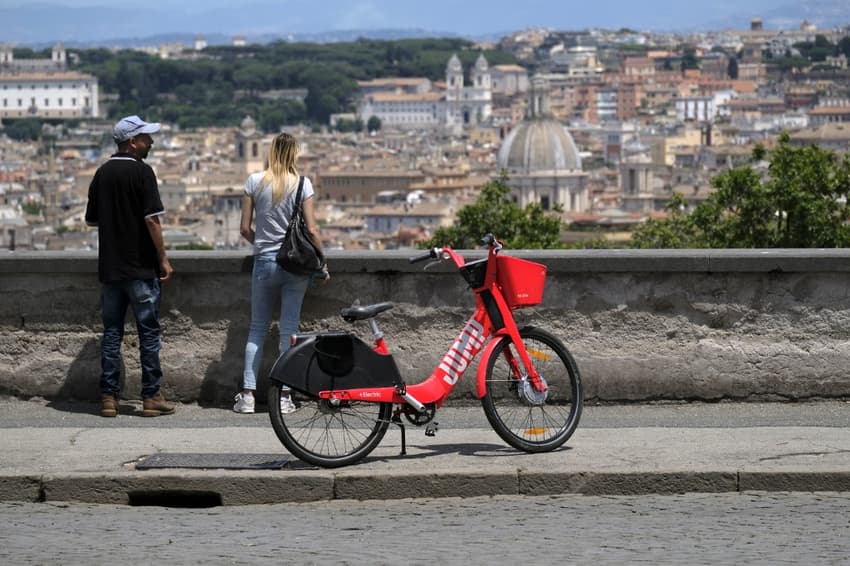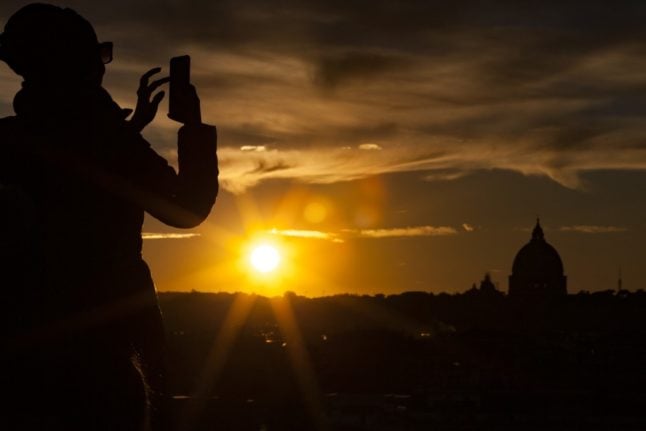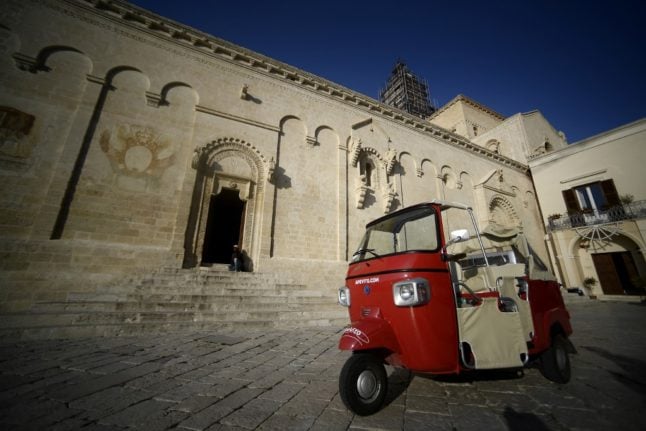TRAVEL: What to expect if you’re returning to Italy this Easter

After two years with limited opportunities to visit Italy, Covid restrictions are easing and travel is resuming. But what should you expect if you haven't visited for a while?
After nearly two years of Covid emergency, Italy has finally relaxed most of its restrictions and the country is eagerly reopening its doors to tourism.
The Easter holidays, which, as far as holidays go in Italy are second only to Christmas celebrations in importance, mark the beginning of the tourist season and this year they're expected to offer the usual wealth of village festivals, food markets, and other activities to enjoy in the warm spring sunlight.
So if you're looking forward to a long-awaited return to Italy over the Easter holidays, here’s a breakdown of what you should expect from your upcoming trip.
Travel rules
The good news is that Italian government has recently relaxed most Covid-related travel rules - but some are still in place.
Quarantine-free travel to Italy is currently allowed from all countries, for any reason. But under extended rules and entry requirements in place until at least April 30th, you'll need to show either a Covid vaccination certificate, recovery certificate or negative test result when entering the country..
READ ALSO: What you need to know about travel to Italy this spring
Italy also requires arrivals to complete a passenger locator form (download it here and here’s how to fill it out).
If you can't provide the required paperwork, you can still enter the country but will have to undergo a five-day quarantine at the address specified on the Passenger Locator Form. Not the best way to spend the Easter break if you ask us.
You can check the latest official information on rules for arrivals to Italy from your country on the Italian Foreign Ministry's website here.
Covid restrictions once in Italy
You should also expect to navigate the domestic Covid health measures still in place for the time being.
Though the rules have been eased in April, Italy's health pass system is still in place.
From April 1st, Italy has scrapped the requirement for hotel guests to show any type of Covid health pass. It is also no longer required to access museums in Italy, or to sit at an outdoor bar or restaurant.
Theatres, cinemas, concert halls, nightclubs, other indoor entertainment venues and indoor sports arenas, however, do require a valid vaccination or recovery certificate.
READ ALSO: Where you now need to show a Covid green pass in Italy
The good news is that visitors are unlikely to need to get hold of an Italian green pass.
All foreign-issued vaccination or recovery certificates are considered equivalent to the Italian super green pass and will give you access to all the same spaces.
You do not need to convert your vaccination or recovery certificate into an Italian green pass as a visitor to Italy.
You can find more detailed information about how the super green pass works for visitors in Italy here.
Masks
Italy no longer requires face masks to be worn in most outdoor public areas, but they're still needed indoors for now.
Though not yet confirmed, Italy is expected to scrap the current rules on face masks on May 1st. That means that if you want to visit any indoor public venues during the Easter holidays, you will still need a face covering.
READ ALSO: How tourists and visitors can get a coronavirus test in Italy
Specifically, FFP2 masks must be worn on all types of transport, whether that be interregional or local. Surgical masks are ok for most other indoor locations such as hotels, bars, restaurants, museums and shops.
What else to expect:
As well as the Covid rules, there are some other practical considerations for a trip to Italy over Easter.
Traffic and travel disruption
Motorway traffic is, as usual, forecast to be heavy in Italy over the long weekend. And no wonder, as a recent survey by the Italian hotel association Federalberghi found that around 14 million Italians are planning to travel within the country over the Easter period.
Good Friday is not a public holiday in Italy, but schools are closed from Thursday and many Italians take the Friday off work to give themselves a ponte (bridge) holiday that stretches into Easter Monday, which means traffic jams traditionally begin on Thursday night.
The worst times for traffic on Italian motorways are predicted to be Friday afternoon and evening, and Monday afternoon.

Photo by Laurent EMMANUEL / AFP
Do your supermarket shop early
Aside from the fact that Italian food shops and supermarkets are usually closed on Sundays and public holidays, this year the prospect of strikes in some regions could mean extended closures.
If you're planning to do a big supermarket shop, make sure you check the opening hours at your local store in advance.
Bring an umbrella
While we may associate Easter with mild, spring-like weather - and some people expect nothing but blazing sunshine when they visit Italy - it can be wet and cold at this time of year.
Unfortunately that has been the case for the past few years, and forecasts appear to confirm the ‘wet Easter’ trend again this time as well
According to the latest reports, cold air currents sweeping down from northern Europe are expected to bring a drop in temperatures between Friday and Saturday.
Other changes
Italy has changed a lot over the past two years and many local habits and social rules might not exactly be the way you remember them.
Arrivederci to the double kiss
During the pandemic, many Italians have kissed goodbye (pun intended) to the two-kiss greeting. While close friends and family members might still occasionally resort to the double peck, the days where you’d kiss complete strangers are far gone.
In fact, the concept of personal space itself has considerably changed in what you may remember as a very touchy-feely culture.
That’s not to say people are now keeping their distance at all times. But, generally speaking, in public spaces such as post offices, public transport or shops, most people have developed a keen inclination to avoid pressing up against one another even when social distancing is not necessarily enforced.
Paying by card is now a realistic option
There were days not so long ago where placing Italy and technological progress in the same sentence would be enough to raise the eyebrows of most Ufficio Indagini officers. So you may be surprised to see that Italy has made some noticeable digital strides in the last two years.
For instance, these days you’re far more likely to be offered the option of paying by contactless card, even for smaller sums.
This is not only due to people preferring card transactions for Covid-related hygiene reasons but it is also part of a wider government scheme to crack down on rampant tax evasion.
Interestingly, the contactless revolution seems to have spread to the farthest corners of the country; so much so that the next time you pay for a ghiacciolo (ice lolly) in a remote Apulian village you might be able to do so with a tap of your card.

Photo by Filippo MONTEFORTE / AFP
Take-out has taken off
While a good number of restaurants in Italy’s major towns and cities offered takeaway food and drinks well before the pandemic, this seems now to be standard all over the country.
Surprisingly, it’s not just restaurants that have expanded their take-out offering. Home delivery in general is more of an option these days, with more and more supermarkets delivering their goods right to your doorstep.
This has been a major change for people in smaller towns and more rural parts of the country, where home deliveries were previously non-existent.
Watch out for e-scooters
Visitors coming back to Italy after a two-year hiatus are liable to be struck (quite literally, unfortunately) by one thing: monopattini (e-scooters) and e-bikes.
When the country started to relax its rules after the first Covid wave, people looked for ways to travel around their city without being crammed into poorly ventilated buses and trams, and app-controlled scooters and bikes offered themselves up as the answer.
In short, the entire country seems to now be in the grip of an electric vehicle craze which isn’t likely to go away anytime soon. So, while visiting, be sure to stop to appreciate the picturesque Italian landscape while also, perhaps, having a look over your shoulder every once in a while.
But don’t worry, most things about the Italy that we know and love are still recognisable – the food and the wine are great, the drivers are terrible, and there may very well be a strike. Viva l'Italia!
Comments
See Also
After nearly two years of Covid emergency, Italy has finally relaxed most of its restrictions and the country is eagerly reopening its doors to tourism.
The Easter holidays, which, as far as holidays go in Italy are second only to Christmas celebrations in importance, mark the beginning of the tourist season and this year they're expected to offer the usual wealth of village festivals, food markets, and other activities to enjoy in the warm spring sunlight.
So if you're looking forward to a long-awaited return to Italy over the Easter holidays, here’s a breakdown of what you should expect from your upcoming trip.
Travel rules
The good news is that Italian government has recently relaxed most Covid-related travel rules - but some are still in place.
Quarantine-free travel to Italy is currently allowed from all countries, for any reason. But under extended rules and entry requirements in place until at least April 30th, you'll need to show either a Covid vaccination certificate, recovery certificate or negative test result when entering the country..
READ ALSO: What you need to know about travel to Italy this spring
Italy also requires arrivals to complete a passenger locator form (download it here and here’s how to fill it out).
If you can't provide the required paperwork, you can still enter the country but will have to undergo a five-day quarantine at the address specified on the Passenger Locator Form. Not the best way to spend the Easter break if you ask us.
You can check the latest official information on rules for arrivals to Italy from your country on the Italian Foreign Ministry's website here.
Covid restrictions once in Italy
You should also expect to navigate the domestic Covid health measures still in place for the time being.
Though the rules have been eased in April, Italy's health pass system is still in place.
From April 1st, Italy has scrapped the requirement for hotel guests to show any type of Covid health pass. It is also no longer required to access museums in Italy, or to sit at an outdoor bar or restaurant.
Theatres, cinemas, concert halls, nightclubs, other indoor entertainment venues and indoor sports arenas, however, do require a valid vaccination or recovery certificate.
READ ALSO: Where you now need to show a Covid green pass in Italy
The good news is that visitors are unlikely to need to get hold of an Italian green pass.
All foreign-issued vaccination or recovery certificates are considered equivalent to the Italian super green pass and will give you access to all the same spaces.
You do not need to convert your vaccination or recovery certificate into an Italian green pass as a visitor to Italy.
You can find more detailed information about how the super green pass works for visitors in Italy here.
Masks
Italy no longer requires face masks to be worn in most outdoor public areas, but they're still needed indoors for now.
Though not yet confirmed, Italy is expected to scrap the current rules on face masks on May 1st. That means that if you want to visit any indoor public venues during the Easter holidays, you will still need a face covering.
READ ALSO: How tourists and visitors can get a coronavirus test in Italy
Specifically, FFP2 masks must be worn on all types of transport, whether that be interregional or local. Surgical masks are ok for most other indoor locations such as hotels, bars, restaurants, museums and shops.
What else to expect:
As well as the Covid rules, there are some other practical considerations for a trip to Italy over Easter.
Traffic and travel disruption
Motorway traffic is, as usual, forecast to be heavy in Italy over the long weekend. And no wonder, as a recent survey by the Italian hotel association Federalberghi found that around 14 million Italians are planning to travel within the country over the Easter period.
Good Friday is not a public holiday in Italy, but schools are closed from Thursday and many Italians take the Friday off work to give themselves a ponte (bridge) holiday that stretches into Easter Monday, which means traffic jams traditionally begin on Thursday night.
The worst times for traffic on Italian motorways are predicted to be Friday afternoon and evening, and Monday afternoon.

Do your supermarket shop early
Aside from the fact that Italian food shops and supermarkets are usually closed on Sundays and public holidays, this year the prospect of strikes in some regions could mean extended closures.
If you're planning to do a big supermarket shop, make sure you check the opening hours at your local store in advance.
Bring an umbrella
While we may associate Easter with mild, spring-like weather - and some people expect nothing but blazing sunshine when they visit Italy - it can be wet and cold at this time of year.
Unfortunately that has been the case for the past few years, and forecasts appear to confirm the ‘wet Easter’ trend again this time as well
According to the latest reports, cold air currents sweeping down from northern Europe are expected to bring a drop in temperatures between Friday and Saturday.
Other changes
Italy has changed a lot over the past two years and many local habits and social rules might not exactly be the way you remember them.
Arrivederci to the double kiss
During the pandemic, many Italians have kissed goodbye (pun intended) to the two-kiss greeting. While close friends and family members might still occasionally resort to the double peck, the days where you’d kiss complete strangers are far gone.
In fact, the concept of personal space itself has considerably changed in what you may remember as a very touchy-feely culture.
That’s not to say people are now keeping their distance at all times. But, generally speaking, in public spaces such as post offices, public transport or shops, most people have developed a keen inclination to avoid pressing up against one another even when social distancing is not necessarily enforced.
Paying by card is now a realistic option
There were days not so long ago where placing Italy and technological progress in the same sentence would be enough to raise the eyebrows of most Ufficio Indagini officers. So you may be surprised to see that Italy has made some noticeable digital strides in the last two years.
For instance, these days you’re far more likely to be offered the option of paying by contactless card, even for smaller sums.
This is not only due to people preferring card transactions for Covid-related hygiene reasons but it is also part of a wider government scheme to crack down on rampant tax evasion.
Interestingly, the contactless revolution seems to have spread to the farthest corners of the country; so much so that the next time you pay for a ghiacciolo (ice lolly) in a remote Apulian village you might be able to do so with a tap of your card.

Take-out has taken off
While a good number of restaurants in Italy’s major towns and cities offered takeaway food and drinks well before the pandemic, this seems now to be standard all over the country.
Surprisingly, it’s not just restaurants that have expanded their take-out offering. Home delivery in general is more of an option these days, with more and more supermarkets delivering their goods right to your doorstep.
This has been a major change for people in smaller towns and more rural parts of the country, where home deliveries were previously non-existent.
Watch out for e-scooters
Visitors coming back to Italy after a two-year hiatus are liable to be struck (quite literally, unfortunately) by one thing: monopattini (e-scooters) and e-bikes.
When the country started to relax its rules after the first Covid wave, people looked for ways to travel around their city without being crammed into poorly ventilated buses and trams, and app-controlled scooters and bikes offered themselves up as the answer.
In short, the entire country seems to now be in the grip of an electric vehicle craze which isn’t likely to go away anytime soon. So, while visiting, be sure to stop to appreciate the picturesque Italian landscape while also, perhaps, having a look over your shoulder every once in a while.
But don’t worry, most things about the Italy that we know and love are still recognisable – the food and the wine are great, the drivers are terrible, and there may very well be a strike. Viva l'Italia!
Join the conversation in our comments section below. Share your own views and experience and if you have a question or suggestion for our journalists then email us at [email protected].
Please keep comments civil, constructive and on topic – and make sure to read our terms of use before getting involved.
Please log in here to leave a comment.